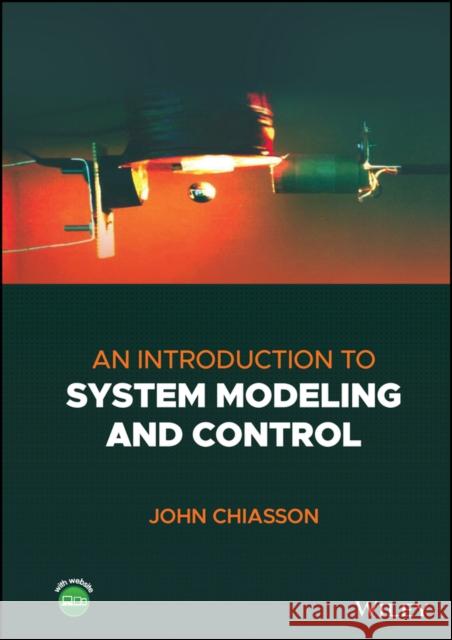An Introduction to System Modeling and Control » książka



An Introduction to System Modeling and Control
ISBN-13: 9781119842897 / Angielski / Twarda / 2022 / 752 str.
An Introduction to System Modeling and Control
ISBN-13: 9781119842897 / Angielski / Twarda / 2022 / 752 str.
(netto: 643,92 VAT: 5%)
Najniższa cena z 30 dni: 670,57
ok. 30 dni roboczych
Bez gwarancji dostawy przed świętami
Darmowa dostawa!
1 Introduction 11.1 Aircraft 11.2 Quadrotors 71.3 Inverted Pendulum 111.4 Magnetic Levitation 121.5 General Control Problem 142 Laplace Transforms 152.1 Laplace TransformProperties 172.2 Partial Fraction Expansion 212.3 Poles and Zeros 312.4 Poles and Partial Fractions 32Appendix: Exponential Function 35Problems 383 Differential Equations and Stability 453.1 Differential Equations 453.2 PhasorMethod of Solution 483.3 Final Value Theorem 523.4 Stable Transfer Functions 563.5 Routh-Hurwitz Stability Test 593.5.1 Special Case - A Row of the Routh Array has all Zeros* 653.5.2 Special Case - Zero in First Column, but the Row is Not Identically Zero* 68Problems 714 Mass-Spring-Damper Systems 814.1 Mechanical Work 814.2 Modeling Mass-Spring-Damper Systems 824.3 Simulation 88Problems 925 Rigid Body Rotational Dynamics 1035.1 Moment of Inertia 1035.2 Newton's Law of Rotational Motion 1045.3 Gears 1115.3.1 Algebraic Relationships Between Two Gears 1125.3.2 Dynamic Relationships Between Two Gears 1125.4 Rolling Cylinder* 117Problems 1256 The Physics of the DC Motor 1396.1 Magnetic Force 1396.2 Single-Loop Motor 1416.2.1 Torque Production 1416.2.2 Wound Field DC Motor 1436.2.3 Commutation of the Single-Loop Motor 1436.3 Faraday's Law 1456.3.1 The Surface Element Vector S 1466.3.2 Interpreting the Sign of 1476.3.3 Back Emf in a Linear DC Machine 1476.3.4 Back Emf in the Single-Loop Motor 1496.3.5 Self-Induced Emf in the Single-Loop Motor 1506.4 Dynamic Equations of the DC Motor 1526.5 Optical Encoder Model 1546.6 Tachometer for a DC Machine* 1576.6.1 Tachometer for the Linear DC Machine 1576.6.2 Tachometer for the Single-Loop DC Motor 1576.7 TheMultiloop DC Motor* 1596.7.1 Increased Torque Production 1596.7.2 Commutation of the Armature Current 159Problems 1637 Block Diagrams 1737.1 Block Diagramfor a DC Motor 1737.2 Block Diagram Reduction 175Problems 1858 System Responses 1918.1 First-Order System Response 1918.2 Second-Order System Response 1938.2.1 Transient Response and Closed-Loop Poles 1948.2.2 Peak Time and Percent Overshoot 1988.2.3 Settling Time 2008.2.4 Rise Time 2028.2.5 Summary of 2028.2.6 Choosing the Gain of a Proportional Controller 2028.3 Second-Order Systems with Zeros 2058.4 Third-Order Systems 210Appendix - Root Locus Matlab File 211Problems 2129 Tracking and Disturbance Rejection 2219.1 Servomechanism 2219.2 Control of a DC Servo Motor 2269.2.1 Tracking 2269.2.2 Disturbance Rejection 2319.2.3 Summary of the PI Controller for a DC Servo 2349.2.4 Proportional plus Integral plus Derivative Control 2349.3 Theory of Tracking and Disturbance Rejection 2389.4 Internal Model Principle 2429.5 Design Example: PI-D Control of Aircraft Pitch 2449.6 Model Uncertainty and Feedback* 250Problems 25810 Pole Placement, 2 DOF Controllers, and Internal Stability 27110.1 Output Pole Placement 27110.1.1 Disturbance Model 27610.1.2 Effect of the Initial Conditions on the Control Design 27810.2 Two Degrees of Freedom Controllers 28310.3 Internal Stability 29210.3.1 Unstable Pole-Zero Cancellation Inside the Loop (Bad) 29510.3.2 Unstable Pole-Zero Cancellation Outside the Loop (Good) 29810.4 Design Example: 2 DOF Control of Aircraft Pitch 30010.5 Design Example: Satellite with Solar Panels (Collocated Case) 303Appendix: Output Pole Placement 306Appendix:Multinomial Expansions 310Appendix: Overshoot 311Appendix: Unstable Pole-Zero Cancellation 315Appendix: Undershoot 317Problems 32011 Frequency Response Methods 33911.1 Bode Diagrams 33911.1.1 Simple Examples 34311.1.2 More Bode Diagram Examples 34511.2 Nyquist Theory 35911.2.1 Principle of the Argument 35911.2.2 Nyquist Test for Stability 36811.3 Relative Stability: Gain and Phase Margins 37711.4 Closed-Loop Bandwidth 38311.5 Lead and Lag Compensation 38711.6 Double Integrator Control via Lead-Lag Compensation 39211.7 Inverted Pendulum with Output 399Appendix: Bode and Nyquist Plots in Matlab 401Problems 40212 Root Locus 41912.1 Angle Condition and Root Locus Rules 42012.2 Asymptotes and Their Intercept 42712.3 Angles of Departure 43412.4 Effect of Open-Loop Poles on the Root Locus 45012.5 Effect of Open-Loop Zeros on the Root Locus 45112.6 Breakaway Points and the Root Locus 45212.7 Design Example: Satellite with Solar Panels (Noncollocated) 453Problems 45813 Inverted Pendulum, Magnetic Levitation, and Cart on a Track 46713.1 Inverted Pendulum 46713.1.1 Mathematical Model of the Inverted Pendulum 46713.1.2 Linear Approximate Model 47013.1.3 Transfer Function Model 47013.1.4 Inverted Pendulum Control Using Nested Feedback Loops 47213.2 Linearization of Nonlinear Models 47513.3 Magnetic Levitation 47813.3.1 Conservation of Energy 47913.3.2 StatespaceModel 48013.3.3 Linearization About an Equilibrium Point 48113.3.4 Transfer Function Model 48313.4 Cart on a Track System 48313.4.1 Mechanical Equations 48413.4.2 Electrical Equations 48513.4.3 Equations of Motion and Block Diagram 486Problems 48814 State Variables 50114.1 Statespace Form 50114.2 Transfer Function to Statespace 50314.2.1 Control Canonical Form 50514.3 Laplace Transform of the Statespace Equations 51314.4 Fundamental Matrix Phi 51614.4.1 Exponential Matrix e^At 51714.5 Solution of the Statespace Equation* 52014.5.1 Scalar Case 52114.5.2 Matrix Case 52214.6 Discretization of a Statespace Model* 523Problems 52515 State Feedback 52915.1 Two Examples 52915.2 General State Feedback Trajectory Tracking 53715.3 Matrix Inverses and the Cayley-Hamilton Theorem 53815.3.1 Matrix Inverse 53815.3.2 Cayley-Hamilton Theorem 54115.4 Stabilization and State Feedback 54315.5 State Feedback and Disturbance Rejection 54715.6 Similarity Transformations 55115.7 Pole Placement 55515.7.1 State Feedback Does Not Change the System Zeros 55915.8 Asymptotic Tracking of Equilibrium Points 56015.9 Tracking Step Inputs via State Feedback 56215.10 Inverted Pendulum on an Inclined Track* 56915.11 Feedback Linearization Control* 574Appendix: Disturbance Rejection in the Statespace 579Problems 58116 State Estimators and Parameter Identification 59516.1 State Estimators 59516.1.1 General Procedure for State Estimation 60016.1.2 Separation Principle 60816.2 State Feedback and State Estimation in the Laplace Domain* 61016.3 Multi-Output Observer Design for the Inverted Pendulum* 61316.4 Properties of Matrix Transpose and Inverse 61516.5 Duality* 61716.6 Parameter Identification 619Problems 62617 Robustness and Sensitivity of Feedback 64117.1 Inverted Pendulum with Output 64117.2 Inverted Pendulum with Output 65517.3 Inverted Pendulum with State Feedback 65717.4 Inverted Pendulum with an Integrator and State Feedback 66117.5 Inverted Pendulum with State Feedback via State Estimation 663Problems 666References 671Index 675
John Chiasson, PhD, is a Fellow of the IEEE and the author of Modeling and High-Performance Control of Electric Machines (Wiley 2005), Introduction to Probability and Stochastic Processes (Wiley 2013), and Differential-Geometric Approach to Nonlinear Control (2021).
1997-2025 DolnySlask.com Agencja Internetowa
KrainaKsiazek.PL - Księgarnia Internetowa









